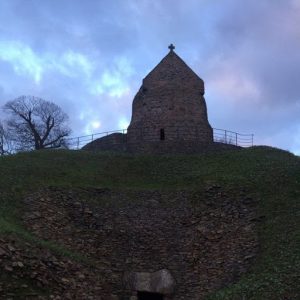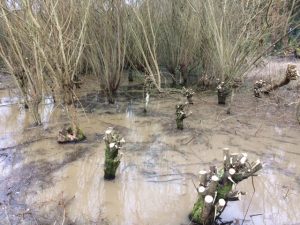Monday 19th March 2018
Winter is baring its teeth one last time with snow flurries and low temperatures at La Hougue Bie. Today saw determined volunteers showing up despite the cold weather to make a start on another week on the Neolithic Longhouse.

This week, our time will be split between the building ad the harvesting of materials for the construction of the walls and roof.
Although my arrival was delayed by snow in Southampton, the volunteers made a start, continuing their efforts on the final sections of wall plate. Derek has shortened two posts to enable more V notches to be cut. Bark stripping and log splitting continued to produce more joists and beams for the floors.
Tuesday 20th March 2018
Spring is officially here! I gathered with a few others inside the passage monument of La Hougue Bie just after 6 o’clock this morning in the hope of seeing the first spring sunlight shine down the passage and into the chamber beyond. The sun rose beautifully – but a bank of cloud prevented the glowing orange show we all hoped for. Still, Winter has turned and we now look forward to those long summer days on the project!

Today saw the volunteers gather at some willow pollards in St Peters Valley. The willow was last cut 3 years ago and has (as willow does) grown impressively since. Pollarding and Coppicing are woodland management techniques that go far back into human history. Coppicing can be practised on a range of tree species including hazel, Willow, Ash, Oak and Sweet Chestnut. The process involves the cutting of all (or selected) living stems as close to the ground as possible. This task must be undertaken in the winter season (when the tree is not actively growing) and forces the tree to throw up many new shoots in the springtime. The coppiced stump has a variety of regional names – “stool” being the common version. In a perfect coppiced wood, the stools are packed closely together to encourage any new growth to grow straight and true to the available light. Coppicing is a traditional method of managing trees for product.

The type of product required is determined by the number of years the stool is allowed to grow before being re-cut. Weaving material for baskets might only be one years’ growth (or less!), weavers for fence building and hurdles (gates) might range between 5 and 7 years growth, poles for construction might range from 15 to 25 years. A coppiced stool must be protected from animal damage to ensure a good crop of timber. This can be done by fencing off the area (or coup) or by cutting the tree at a height beyond browsing animals – the principles are exactly the same but the process is referred to as pollarding.

Today the volunteers experienced the mud and welly deep water that is pollarding in a low lying valley! The main stems from each tree were cut and each stem then processed into thick medium and thin rods. The work was carried out with axes, saws and billhooks.

Although the piles of material after day one look impressive, the Longhouse will very quickly eat up this material in the form of roof battens, thatching sways, hurdle walls and hurdle mezzanine floors – it will be interesting to see how far this material goes towards finishing the basic structure of the house.
Wednesday 21st March 2018

This morning saw a second attempt at sunrise at Hougue Bie – and what a difference! The light crept into the darkest recesses of the chamber, turning the granite a burnished bronze colour – there really is something special about seeing it happen and watching the light move across the stones as the day unfolds – fantastic!



The second day of coppicing began some time later and once again, the volunteers worked their socks off to finish the job. Dave Pittom’s (volunteer) son Alex, very kindly offered his truck to move the willow to the Longhouse tomorrow – a very kind and useful gesture which will save us a great deal of time.

We now have enough willow to make a start on the walls and roof of the project. We are also planning on using the willow bark to make strapping for the building – experiments begin tomorrow!



Thursday 22nd March 2018
There was an early start this morning for volunteers who came to la Hougue Bie in the hope of a clear sunrise. Clouds prevented the spectacle of yesterday from happening again, but a fire and bacon butties made up for the disappointment!

The harvested willow arrived this morning – kindly delivered by Alex Wareham’s scaffolding truck. Dave the driver and Dave Pittom were fantastically helpful in the traffic management during the unloading. It was only as the willow was heaped on site that we realised just how well we had done in the last two days of harvesting!

Today the volunteer teams are swinging into action on several tasks. Nicky, Ruth and Iris are working methodically through the positioned rafters to adjust them (where necessary) and to finally lash them in position. The rafters need to cross at the apex of the roof, be lashed to the ridge beam, purlin and wall plate and overhang the walls to create an eave. Lashings need to be neat and strong as they will eventually ensure the strength of the roof.


Astra and Murray are working on stripping some of the fresh willow. The stripped bark will be boiled in its own outer bark to effectively tan the inner bark and create strong strapping for future lashings.

Carol, Danny and James are sorting through the huge pile of willow and sorting into usable piles for the roof and wattle walls.
Derek, Bill and Rosie are working on the final fitting of wall plate 6b and 7b. That will leave just one final wall plate section to fit!
Paul, Mike and Edward are running an education workshop with a visiting school – explaining the building and project, polishing a flint axe and having a go at chopping with one too!

.
Friday 23rd March 2018
The sun is shining and there is a Spring warmth in the air. Today we continue with lashing rafters into their final positions. Some of the thicker willow stems are being lashed into place at battens. These are placed at 40cm intervals up the rafters to effectively form a ladder. This ladder will not only bear the weight of thatch but also provide tying on points to hold the thatch in place.

At last, the final stages of the roof structure have begun. It won’t be long now before the thatching begins!

It’s been another good week on the project with our time split between the harvesting of materials and their use on the building.


This week has really highlighted the volume of effort required to produce a building like this in terms of harvesting and processing. Rope making is still an epic task that requires a great deal of preparation to get right. any good quality cordage requires large volumes of effort and skill, not just in the harvesting and preparation of materials, but in the physical production of the cordage itself. What becomes obvious as we test these methods, is the level of refined knowledge our ancestors must have had in their daily lives, and how that knowledge would have affected the timing (daily and seasonal) of various tasks to ensure the most efficient and effective use of materials.
Our harvested willow is not peeling as well as it would in just a couple of weeks time – to prevent disturbance of nesting birds. The result is that more effort is required to strip the bark in order to make cordage. James, after some good ideas has developed a good method of removing the bark by tapping the stem with a mallet. It is this ingenuity in the face of adversity that has seen humans move from the stone age to walking on the moon in just 10,000 years!!


